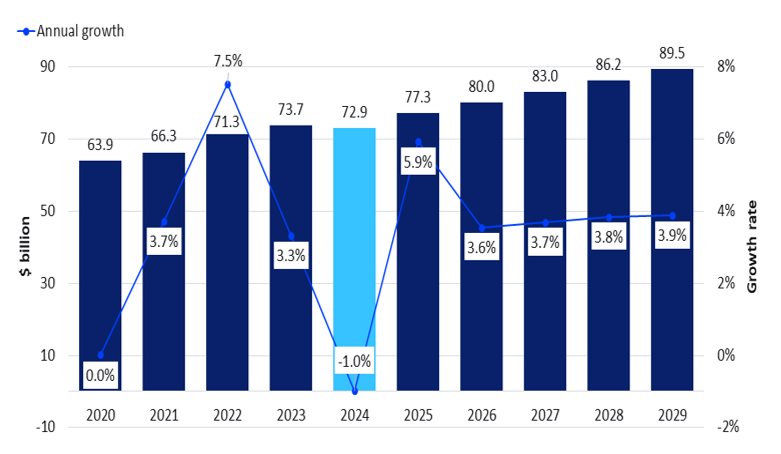Operation Sindoor was not just a mission to teach the enemy a lesson but was also a show of the manufacturing and technological prowess that the country commands in modern defence systems.
WAR is never desirable, nor productive. But is it the complete truth? Even defence expenditure was considered unproductive. But that was in a world that belonged to a different era. In today's world, where a country faces relentless border skirmishes and the internal peace and security of the citizens is threatened by neighbouring state(s), war often becomes unavoidable and defence expenditures an absolute necessity. Even "Chanakya Niti", specifically in the context of common borders, emphasizes adopting a strategic approach reinforced by the principle that neighbouring states are inherently potential enemies. Under such circumstances, defence expenses are a necessary evil that needs to be fed continuously – bigger and better technologies and weaponries.
If we go by global standards, the Global defence spending reached $2.7 trillion in 2024, marking a significant increase (9.4% over 2023) and the steepest rise since the end of the Cold War [1].

Figure 1: Military expenditure across the Globe (by region) 1988–2024
Note: Data for the Soviet Union in 1991 being unavailable, no total can be calculated for that year.
Source: SIPRI Military Expenditure Database, Apr. 2025 [1].
The above illustration indicates continued annual increase of military spending across the world for a full decade, resulting in a 37% increase between 2015 and 2024. Intensifying conflicts and increased geopolitical tensions, specifically in Europe and the Middle East have been the key contributors to this steep rise in defence expenses. Europe saw its military spending rising by 17% to $693 bn making it the principal contributor to the global rise.
The Indian Context
Ever since we remember, India has been facing border problems with Pakistan and has been to war with this neighbour multiple times – covert and overt. The problems of insurgencies and terrorism have been imposed on it and feels like an eternal problem. If the country is to prosper economically, maintaining internal peace and stability and maintaining a safe homeland environment are priorities. We cannot let militancy disrupt our economic activities on a day to day basis. And what better way to do that other than boosting our defence prowess and homeland security?
Where do we stand globally in terms of defence spending?
Total military expenditure accounted for 2.5% of the global GDP in 2024. The top 5 spenders in 2024 were the U. S., China, Russia, Germany and India, which together accounted for 60% of world military spending [1].
The Indian defence sector has swelled in terms of manufacturing and R&D capabilities. This has been an obvious outcome of boosting the country's military prowess. Rather than depending on foreigners India believed in building its own manufacturing capabilities which was boosted through the "Make in India" policy.
According to the Indian Government
"India's defence production has grown at an extraordinary pace since the launch of the "Make in India" initiative, reaching a record ₹1.27 lakh crore in FY 2023-24, with defence exports rising to an all-time high of ₹23,622 crore in FY 2024-25. Once dependent on foreign suppliers, the country now stands as a rising force in indigenous manufacturing, shaping its military strength through home-grown capabilities. This shift reflects a strong commitment to self-reliance, ensuring that India not only meets its security needs but also builds a robust defence industry that contributes to economic growth."

Fig 1: India's Defence Budget (₹lakh Crore)
Source: https://www.pib.gov.in/PressReleasePage.aspx?PRID=2116612

Figure 2: Defence Expense ($ Bn) & Growth (%) during 2020-29
Defence Expenditure is now a key contributor to the country's economic growth. It has provided significant boost to sectors such as manufacturing, metallurgy, technology, auto, and generated significant employment all around.
There has been steady spent on defence, as is evident from the GoI's defence budget. This spent can never be categorised as not unproductive. Besides ensuring the country's safety, security and geopolitical stability, the defence spent boosts the manufacturing sector. A sizeable portion of the spending goes to the companies manufacturing weapons, uniforms, vehicles, digital and other equipment used by the defence personnel. This boosts the government spending which again boosts demand side of the economy and the money flows to several sectors including auto, IT, chemicals and textile. It's not unproductive. For a country like India where there are constant disturbances along border areas, defence spend is necessary to ensure the country's security which again is necessary for carrying out economic activities unabated.
Export Earner
The defence sector contributes handsomely towards our export earnings. Defence exports have surged to ₹236 bn in FY25 from ₹46 bn in FY18, a surge of over 5 times in just about 7 years. If this kind of growth continues (and it is most likely to continue given the conducive environment), it will not be difficult for India to reach the declared target of ₹500 bn worth of exports by FY30.

Figure 3: Defence Exports Growth
FY25 saw defence exports rising to ₹15,233 cr from the private sector and ₹8,389 cr from DPSUs, up from ₹15,209 cr and ₹5,874 cr in the previous fiscal. According to the Government " Our defence exports, which were around Rs 600-700 crore 10 years ago, have surpassed a record figure of Rs 24,000 crore today. Our weapons, systems, sub-systems, components, and services are reaching around 100 countries." [2].
DPSU exports saw 42.85% growth in FY25, which reflects growing acceptance of Indian defence products at the global levels and industry integration into the global supply chain.
Manufacturing Growth
Annual defence production crossed all-time high figure of Rs 1,46,000 crore and Make-in-India played a key role during Operation Sindoor. Op Sindoor aptly displayed not only our military prowess but also showcased the growing hi-tech manufacturing capability of the country when it comes to sophisticated defence equipment and technology. "through the Advanced Medium Combat Aircraft (AMCA) programme Execution Model, the private sector will get an opportunity to participate in a mega defence project along with public sector companies for the first time, further bolstering indigenous defence capabilities" [2]. This initiative (the synergy between the public and the private sector) is being considered a big step towards propelling the nation to a developed state from its present status of a developing country by 2047.
Defence PSUs are now sitting on robust and expanding order books. Hindustan Aeronautics' order book was more than 6x its FY25 consolidated revenue as on 31 March 2025. Bharat Electronics Ltd has an orderbook to revenue ratio of over 3x. There are several other players who are witnessing their order book bulging with orders while a lot more remains in the offing. The Defence Acquisition Council (DAC) has already approved orders worth Rs 8.45 trillion over FY22–25, which is almost 3.3x of the amount that got sanctioned during the previous 3 years. This is expected to transform into substantial order inflows for defence shipyards in FY26–27 [2].
It is, therefore, quite obvious why the defence companies are expected to witness good earnings growth, at least in the near future.
Job Creator
The sector also generates significant employment. The Ministry of Defence in India is the world's largest employer with 2.99 million employees in 2024. The US Department of Defence is the second-largest, employing 2.93 million people, followed by China's People's Liberation Army with 2.55 million employees.

Figure 4: Largest Employers – Globally
(Source: https://www.facebook.com/EmmanuelMotelin/posts/top-10-largest-employers-in-the-world-1-ministry-of-defence-299m2-department-of-/1245857070883330/)
The "Make in India" initiative along with the emphasis on domestic manufacturing, has led to a surge in defence exports and production, boosting local industries and creating job opportunities across the sector. Under the present circumstances this sector is poised for further and significant growth. Solid factors such as exponential exports growth, continued government support, and modernization plans will continue to support the defence story. Irrespective of the political orientation of the ruling party, boosting our defence will always be at the top of Indian government's priority list.
A word of caution
As investors, we should not look at just one side of the story. Every story has a downside as well. In our home-grown defence capability story as well, there is a flip side. Several of these companies have significantly high valuations.
In the past, several of the defence PSUs traded at an average PE ratio of 15-25 while good quality private firms' PE lay in a bit higher range of 25-35. However, presently the valuations for nearly all defence stocks have run up to roughly twice their past levels. In some cases, the valuation multiples are even higher.
A rationale behind commanding high valuations is that the investors have realised that defence stocks are no longer the slow, boring stocks of the past, their growth trajectories have altered. At present defence is an exciting industry offering excellent growth potential which is why markets are rewarding them with higher valuations.
But we need to keep in mind that high PE multiples come with high expectations from the shareholders. They expect the companies to perform well and sustain these high-performance levels to justify the investors continued interest in these stocks. If and when the companies fall short of these expectations, there could be serious stock price corrections.
Investing in defence companies blindly is never suggested. For any investor, trusting the valuations pays over the long term. Where growth stories support valuation, the chances of falling flat on the face are less. As of now the growth story remains robust and sustainable.
References
[1] SIPRI, "Unprecedented rise in global military expenditure as European and Middle East spending surges | Stockholm International Peace resaerch Institute," 25 Apr 2025. [Online]. Available: https://www.sipri.org/media/press-release/2025/unprecedented-rise-global-military-expenditure-european-and-middle-east-spending-surges. [Accessed 26 May 2025].
[2] PIB, Ministry of Defence, "Make-in-India played a key role during Operation Sindoor; AMCA Execution Model to allow private sector to further bolster indigenous capabilities; Govt-Industry synergy can make India a developed nation by 2047: Raksha Mantri," 29 May 2025. [Online]. Available: https://www.pib.gov.in/PressReleasePage.aspx?PRID=2132239#. [Accessed 29 May 2025].
[3] Outlook Business, "Bharat Electronics Shares Buck Profit Booking in Defence Names, Robust Order Books Lifts Mood," 20 May 2025. [Online]. Available: https://www.outlookbusiness.com/markets/bharat-electronics-shares-buck-profit-booking-in-defence-names-robust-order-books-lifts-mood. [Accessed 29 May 2025].









